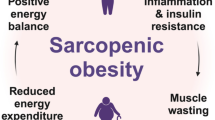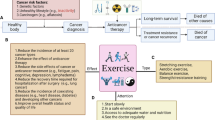Abstract
Cancer cachexia affects about half of all cancer patients and is associated with negative effects on functional status and quality of life. This condition is also a major contributor to the morbidity and mortality of patients with advanced malignancy. Although current strategies to improve appetite and lean body mass by administering appetite stimulants, increasing physical activity and using nutritional supplementation have a scientific rationale, randomised studies have continued to demonstrate that a reduction in the loss of lean body mass is difficult to achieve unless the underlying metabolic abnormalities in cancer cachexia are corrected. Initial studies using animal models have demonstrated that nuclear factor-κ B (NF-κB) is upregulated in cancer cachexia, increasing proteolysis and breakdown of myofibrillar proteins, which results in sarcopenia. Laboratory studies have shown that eicosapentaenoic acid (EPA), an n-3 fatty acid, has anticachectic effects and may attenuate protein degradation by preventing NF-κB accumulation in the nucleus. EPA is associated with weight stabilisation, gain in lean body mass, and improvement in quality-of-life markers in weight-losing patients with advanced pancreatic cancer. Although animal studies have demonstrated the molecular basis of the effects of EPA, this has never been validated in human clinical trials. On the basis of the promising results of the laboratory and clinical studies, we hypothesise that selective targeting of proteasome activity by EPA (a polyunsaturated fatty acid) administered to cancer patients, including elderly patients, with cancer cachexia will alter metabolic abnormalities by downregulating NF-κB, modulating immune and inflammatory response and thus preventing the breakdown of myofibrillar proteins. This will result in promotion of anabolism, reduction of weight loss and increase in lean body mass and physical function, thus establishing a case for future, prospective clinical trials.

Similar content being viewed by others
Notes
The use of trade names is for product identification purposes only and does not imply endorsement.
References
Fearon KC, Von Meyenfeldt MF, Moses AG, et al. Effect of a protein and energy dense N-3 fatty acid enriched oral supplement on loss of weight and lean tissue in cancer cachexia: a randomised double blind trial. Gut 2003 Oct; 52(10): 1479–86
Tisdale MJ. Wasting in cancer. J Nutr 1999 Jan; 129 Suppl.: 243S–6S
Barton BE. IL-6-like cytokines and cancer cachexia: consequences of chronic inflammation. Immunol Res 2001; 23(1): 41–58
Mantovani G, Madeddu C, Gramignano G, et al. Association of serum IL-6 levels with comprehensive geriatric assessment variables in a population of elderly cancer patients. Oncol Rep 2004 Jan; 11(1): 197–206
Hamerman D. Molecular-based therapeutic approaches in treatment of anorexia of aging and cancer cachexia. J Gerontol A Biol Sci Med Sci 2002 Aug; 57(8): M511–8
Dempsey DT, Mullen JL. Macronutrient requirements in the malnourished cancer patient. Cancer 1985; 55: 290–4
Kinsella K, Velkoff VA. An aging world: 2001. Washington, DC: US Census Bureau, 2001 Nov. Series P95/01-1
Vellas B, Lauque S, Andrieu S, et al. Nutrition assessment in the elderly. Curr Opin Clin Nutr Metab Care 2001 Jan; 4(1): 5–8
Pirlich M, Lochs H. Nutrition in the elderly. Best Pract Res Clin Gastroenterol 2001 Dec; 15(6): 869–84
Huffman GB. Evaluating and treating unintentional weight loss in the elderly. Am Fam Physician 2002 Feb; 65(4): 640–50
Morley JE. Pathophysiology of anorexia. Clin Geriatr Med 2002 Nov; 18(4): 661–73
Morley JE. Anorexia and weight loss in older persons. J Gerontol A Biol Sci Med Sci 2003 Feb; 58(2): 131–7
Whitehouse AS, Tisdale MJ. Increased expression of the ubiquitin-proteasome pathway in murine myotubes by proteolysis-inducing factor (PIF) is associated with activation of the transcription factor NF-κB. Br J Cancer 2003 Sep; 89(6): 1116–22
Smith HJ, Tisdale MJ. Signal transduction pathways involved in proteolysisinducing factor induced proteasome expression in murine myotubes. Br J Cancer 2003 Nov; 89(9): 1783–8
Whitehouse AS, Khal J, Tisdale MJ. Induction of protein catabolism in myotubes by 15 (S)-hydroxyeicosatetraenoic acid through increased expression of the ubiquitin-proteasome pathway. Br J Cancer 2003 Aug; 89(4): 737–45
Wigmore SJ, Ross JA, Falconer JS, et al. The effect of polyunsaturated fatty acids on the progress of cachexia inpatients with pancreatic cancer. Nutrition 1996 Jan; 12 (1 Suppl.): S27–30
Mitch WE, Price SR. Transcription factors and muscle cachexia: is there a therapeutic target? Lancet 2001 Mar; 357(9258): 734–5
Schneider SM, Al-Jaouni R, Pivot X, et al. Lack of adaptation to severe malnutrition in elderly patients. Clin Nutr 2002 Dec; 21(6): 499–504
Laviano A, Meguid MM, Rossi-Fanelli F. Cancer anorexia: clinical implications, pathogenesis, and therapeutic strategies. Lancet Oncol 2003 Nov; 4(11): 686–94
Tisdale MJ. Cachexia in cancer patients. Nat Rev Cancer 2002 Nov; 2(11): 862–71
Tisdale MJ. The ‘cancer cachectic factor’. Support Care Cancer 2003 Feb; 11(2): 73–8
Ravasco P, Monteiro-Grillo I, Vidal PM, et al. Cancer: disease and nutrition are key determinants of patients’ quality of life. Support Care Cancer 2004; 12(4): 246–52
Wallace JI, Schwartz RS. Epidemiology of weight loss in humans with special reference to wasting in the elderly. Int J Cardiol 2002 Sep; 85(1): 15–21
Desport JC, Gory-Delabaere G, Blanc-Vincent MP, et al. FNCLCC. Standards, options and recommendations for the use of appetite stimulants in oncology (2000). Br J Cancer 2003 Aug; 89Suppl. 1: S98–100
Golden AG, Daiello LA, Silverman MA, et al. University of Miami division of clinical pharmacology therapeutic rounds: medications used to treat anorexia in the frail elderly. Am J Ther 2003 Jul–Aug; 10(4): 292–8
Walsh D, Nelson KA, Mahmoud FA. Established and potential therapeutic applications of cannabinoids in oncology. Support Care Cancer 2003 Mar; 11(3): 137–43
Karcic E, Philpot C, Morley JE. Treating malnutrition with megestrol acetate: literature review and review of our experience. J Nutr Health Aging 2002 May; 6(3): 191–200
Morley JE. Orexigenic and anabolic agents. Clin Geriatr Med 2002 Nov; 18(4): 853–66
Barber MD, Fearon KC, Tisdale MJ, et al. Effect of a fish oil-enriched nutritional supplement on metabolic mediators in patients with pancreatic cancer cachexia. Nutr Cancer 2001; 40(2): 118–24
Barber MD, Fearon KC. Tolerance and incorporation of a high-dose eicosapentaenoic acid diester emulsion by patients with pancreatic cancer cachexia. Lipids 2001 Apr; 36(4): 347–51
Barber MD, McMillan DC, Preston T, et al. Metabolic response to feeding in weight-losing pancreatic cancer patients and its modulation by a fish-oilenriched nutritional supplement. Clin Sci (Lond) 2000 Apr; 98(4): 389–99
Kumar NB, Cantor A, Allen K, et al. The specific role of isoflavones in reducing prostate cancer risk. Prostate 2004 May; 59(2): 141–7
Al-Jaouni R, Schneider SM, Filippi J, et al. Evolution of body composition during weight loss in elderly malnourished patients: a longitudinal study. Clin Nutr 2003 Aug; 22Suppl. 1: S4
Nutrition Assessment of Adults. Manual of clinical dietetics. Chicago (IL): The American Dietetic Association, 1992
Frisancho AR. Anthropometric standards for the assessment of growth and nutritional status. Ann Arbor (MI): University of Michigan Press, 1990
Kumar NB, Cantor A, Allen K, et al. Android obesity at diagnosis and breast carcinoma survival. Cancer 2000 Jun; 88(12): 2751–7
Kumar NB, Allen K, Cantor A, et al. Weight gain associated with adjuvant tamoxifen therapy in stage I and II breast cancer: fact or artifact. Breast Cancer Res Treat 1997; 44: 135–43
Kumar NB, Lyman GH, Allen K, et al. Timing of weight gain and breast cancer risk. Cancer 1995; 76(2): 243–9
Schapira DV, Kumar NB, Lyman GH, et al. Upper body fat distribution and endometrial cancer risk. JAMA 1991; 266: 1808–11
Schapira DV, Kumar NB, Lyman GH, et al. Abdominal obesity and breast cancer risk. Ann Intern Med 1990; 112: 182–6
Laye S, Gautron L. Cytokines and nutritional disorders [in French]. J Soc Biol 2003; 197(2): 123–31
Kazi A, Urbizu DA, Kuhn DJ, et al. A natural musaceas plant extract inhibits proteasome activity and induces apoptosis selectively in human tumor and transformed, but not normal and non-transformed, cells. Int J Mol Med 2003 Dec; 12(6): 879–87
Kazi A, Daniel KG, Smith DM, et al. Inhibition of the proteasome activity, a novel mechanism associated with the tumor cell apoptosis-inducing ability of genistein. Biochem Pharmacol 2003 Sep; 66(6): 965–76
Barber MD, McMillan DC, Wallace AM, et al. The response of leptin, interleukin-6 and fat oxidation to feeding in weight-losing patients with pancreatic cancer. Br J Cancer 2004 Mar; 90(6): 1129–32
Barber MD, Wigmore SJ, Ross JA, et al. Proinflammatory cytokines, nutritional support, and the cachexia syndrome: interactions and therapeutic options [abstract]. Cancer 1998 Mar; 82(5): 1000
Mantovani G, Maccio A, Mura L, et al. Serum levels of leptin and proinflammatory cytokines in patients with advanced-stage cancer at different sites. J Mol Med 2000; 78(10): 554–61
Baracos VE. Management of muscle wasting in cancer-associated cachexia. Cancer 2001; 92(6 Suppl.): 1669–77
Schag CC, Heinrich RL, Ganz PA. Karnofsky performance status revisited: reliability, validity, and guidelines. J Clin Oncol 1984; 2: 187–93
Acknowledgements
We thank Jayne Wellner for her assistance with the data management and in the preparation of this manuscript. No funding was used to assist in the preparation of this review. The authors have no conflicts of interest directly relevant to the contents of this review.
Author information
Authors and Affiliations
Corresponding author
Rights and permissions
About this article
Cite this article
Kumar, N.B., Dalton, K. Eicosapentaenoic Acid. Evid-Based-Integrative-Med 1, 189–194 (2004). https://doi.org/10.2165/01197065-200401030-00006
Published:
Issue Date:
DOI: https://doi.org/10.2165/01197065-200401030-00006




